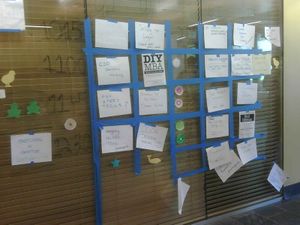TPAC/2011/FAQ
This FAQ is part of the TPAC 2011 Plenary Day wiki.
Why are we using this new format for the Plenary day?
We are hoping this format will generate more interactive discussion, and make it easier for all to participate. Also, since the W3C community has such wide-ranging interests, we hope this format will enable each attendee to spend more time on his/her topics of interest.
How does it work?
The basic concept is that the meeting attendees organize the topics and groups on-the-fly at the meeting. It's a simple as writing a proposed topic on a piece of paper, and sticking it on the wall in a grid of rooms and times.

(Per the agenda, we will do this from 10:00-11:15.)
The TPAC2011 Program Committee has invited attendees to 'seed' the day with early topic proposals, via submission to this wiki Don't be shy. If you have an idea for a potential topic, but aren't sure anyone else is interested -- put it in the wiki! As with brainstorming, there is no failure; all ideas are good, even if they don't end up with a lot of participation. Maybe your idea will jog someone else's brain with a new idea, which would be valuable.
Please read a history on how BarCamps and other 'unconferences' originated, and for examples from around the world.
How many people have to be in a discussion group?
There is no designated number of participants per discussion. It is dependent on how many people are interested in that topic. 2 enthusiastic people could come up with great ideas, or 50. Enthusiasm, participation, and supportive collaboration are more important attributes than a specific number.
Can a session span more than one time slot?
In theory, yes. We will determine room allocation in the agenda-building session.
How are plenary topics chosen?
There are two 30-minute plenary slots in the morning. The Program Committee (PC) will choose two topics from among those proposed. The PC encourages people to leave notes of support in the wiki to help the PC decide.
Plenary proposals that are not selected may be reproposed as breakout sessions.
What if no one comes to my session?
Darn! But such is life. You still get accolades for sharing an idea and trying to elicit discussion. As stated elsewhere, you never know which new concept will spark someone else's breakthrough idea. The more ideas people contribute, the more possibilities we have to consider. If no one said anything, we would go nowhere.
We encourage you to use the wiki and build momentum early for your session to help ensure it is enthusiastically attended.
What if there are more proposals than there are rooms?
We are planning 7 discussion groups in each of 4 time slots. If there are more ideas than that, we encourage groups to be creative about where they meet. Could you sit outside? Is your group small enough to cluster in a corner of the lobby?
What if I think of a great idea for a session in the middle of the day?
Propose your breakout idea anyway! New ideas for breakouts may be spawned by conversations during the day -- let's grow from them. ***Comment from AnnB to Program Committee: could we designate a space on 'The Grid', where people can put up last minute ideas for breakout sessions? That way everyone could see that these are new additions.***
What else ...??
... would you like to know? Put your question here and we'll answer. Or send it to ann.bassetti@boeing.com and I'll add it.